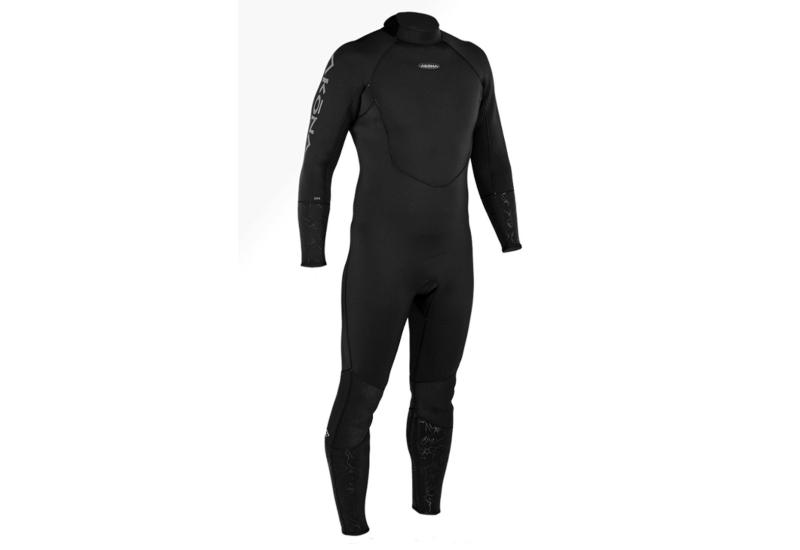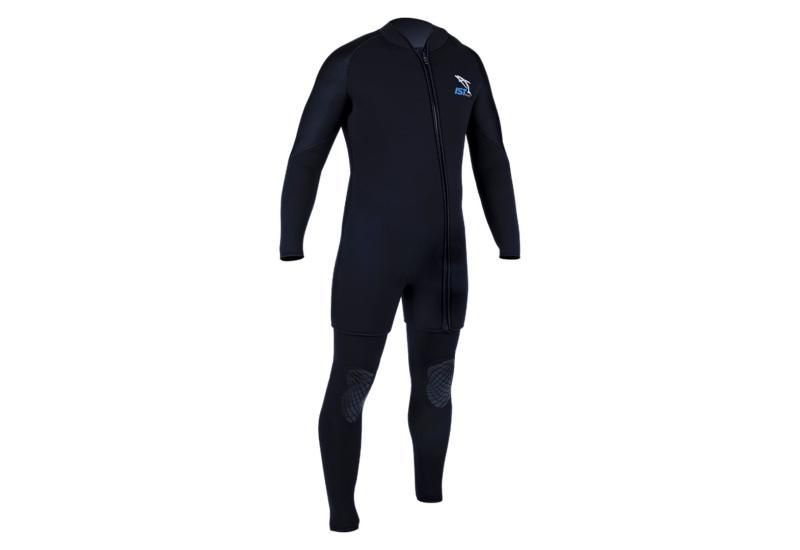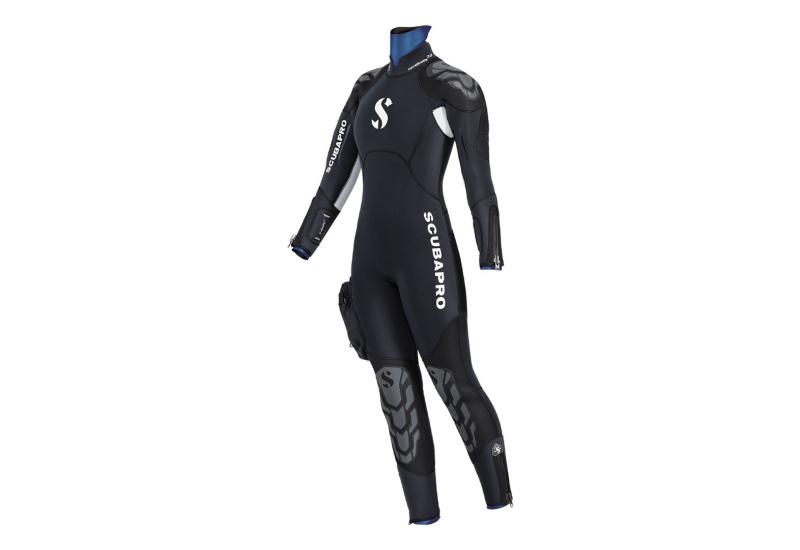12 Temperate Water Wetsuits
By Bill Kendig
Photography by Joseph Byrd
||
|---|
12 Temperate Water Wetsuits Chart--(136K PDF)
| 
 |
Even in the tropics, divers have to guard against thermal loss, but for divers who blow bubbles in chilly, temperate conditions--water ranging from the low 50s to the low 70s--staying warm is imperative. When the water's this cold, it doesn't take much to get uncomfortably chilled and stay that way. Good news: Today's 7mm wetsuits offer better fit, features, comfort and thermal protection than ever before. In this review, Scuba Lab takes a look at 12 new 7mm wetsuits, but first, let's review how a wetsuit really works.
Wetsuit Basics
Wetsuits are made with neoprene rubber, a closed-cell foam that traps millions of tiny gas bubbles. These bubbles in the neoprene act as insulation, and this, combined with a snug, sealed fit that minimizes the amount of cold water that enters the suit, is what keeps your body heat from escaping. In order for a wetsuit to keep you warm, it should: 1) be thick enough for the temperature of the water you're diving in, 2) have seams, seals and zippers that minimize water intrusion, and most important, 3) fit like a second skin.
Materials
Stretch vs. Warmth
A layer of material, usually nylon, lines each side of a wetsuit's neoprene rubber. The purpose of the outer layer is to provide some protection for the neoprene, while the inner layer, or lining, is more for comfort. Some suits use no inner lining, and instead have a smooth-skin interior. This offers more warmth because the whole suit seals against your skin, minimizing or even eliminating water flow, a key feature of an effective wetsuit. The downside: wetsuits with smooth-skin interiors, with some notable exceptions, are more difficult to put on and take off, and the inside of the suit is more prone to damage.
The trend in recent years, especially in 7mm suits, is toward more stretchy neoprene to increase comfort and flexibility. A stretchier suit is easier to put on, is super comfortable and is able to maintain a snug fit by conforming to your body. The downside: stretchier neoprene compresses more at depth than denser, stiffer, standard-stretch neoprene, reducing its insulation capabilities. Because of this, some wetsuit manufacturers use more traditional compression-resistant neoprene, which is then cut into anatomically shaped panels and sewn together to add flexibility.
Seams
Keep Them Watertight
Nearly all seams on 7mm wetsuits are glued and blind-stitched. First, the suit's neoprene panels are glued with two or three coats of neoprene cement. Next, the seams are sewn together to prevent them from pulling apart. This is done with a blind-stitch, where a needle penetrates only the top layer of the material on either side of the seam, without punching all the way through the neoprene.
There are slightly different methods used in creating a durable waterproof seam. One is running a bead of liquid silicone-based urethane over the glued seam on the opposite side of a blind-stitched seam, making one side of the seam look like it's been "welded" together. This process is more waterproof, since you're not poking holes in the neoprene on one side, and more durable because the liquid weld bonds to the seam virtually everywhere contact has been made, rather than just at the stitch points. Glued-and-taped is another method, where flexible bonding tape is applied with heat and pressure over the glued seam on both sides, eliminating the need for any stitches at all.
Seals
The More the Better
Some water always seeps into a wetsuit, but the goal is to keep it to a minimum. The most common water entry points, in order of importance, are the neck, wrists and ankles. Some manufacturers put sealing systems on these entry points. Starting with the most effective, they are:
|||
|---|---|
|

|
Rolled or fold-under smooth-skin seals. This seal, often found on dry suits, is a long cuff of neoprene with smooth skin on the outside that you roll or fold under so the smooth-skin side seals against your bare skin. It's a very efficient seal and easy to apply, but it tends to be a bit bulky.
|||
|---|---|
|

|
Smooth-skin seals. This is a length of smooth-skin material that runs up the wrists and ankles and/or around the neck. Sealing against bare skin, it provides excellent protection--if the seal isn't broken. Generally, the farther the smooth-skin extends up the forearms and calves, the less likely the seal will be broken. This happens often on ankle seals, where the smooth-skin isn't long enough to reach above the top edge of a diver's tucked-in boot.
|||
|---|---|
|

|
Gasket seals. Basically, these are nylon cuffs at the wrists and ankles, with a one-inch-wide smooth-skin gasket or flap farther up on the forearms and calves. This gasket seals against bare skin and keeps water from getting any farther into the suit, plus keeps boots or gloves from breaking the seals. Be extra careful that the smooth-skin seal doesn't get creased or pinched when pulling on the suit.
|||
|---|---|
|

|
O-ring seals. This is a smooth-skin ring seal, located at the hem of the wrist or ankle cuff, which doesn't get in the way when donning or doffing the suit. However, such a narrow ring of smooth-skin against bare skin creates a seal that is easy to break.
A note on neck seals: 7mm suits are designed for temperate to cold water, environments that require not only a thick suit but a hood. Most wetsuit hoods tuck inside the collar, but this generally breaks whatever neck seal the wetsuit has. If you wear a standard wetsuit hood, don't worry about what kind of neck seal the wetsuit has; instead, tuck in the hood and then adjust the collar as snug as possible to minimize water flow. If the wetsuit has a first-rate neck seal and you don't want to lose it, consider wearing a dry suit hood. These overlap the collar rather than tuck inside, maintaining the integrity of the seal. Another option: some manufacturers offer wetsuit hoods that have a band of smooth-skin sewn around the neck. Tuck the hood into the collar of the suit so that the smooth-skin band makes contact with the smooth-skin neck seal. They bond together, preserving the seal and keeping you dry, warm and comfortable.
Zippers
Often Overlooked
||
|---|
|

|
| |
|

|
| |
|

|
Choosing a 7mm suit with a vertical back zipper or one with a horizontal front zipper is a matter of preference. Front-zipper suits tend to be easier to put on, but the zipper track can affect flexibility in the chest and shoulder areas. Back zippers lay in line with the spine and tend to be more comfortable, but you may need help when zipping up. Whether back or front, the zipper creates the greatest potential for water entry. To combat this, most suits have a zipper underflap that lies between a diver's bare back and a heavy-duty zipper track (A), which helps block water flow (and adds cushioned comfort). Some suits use two sections of smooth-skin neoprene, one on each edge of the zipper track (B). When the zipper is zipped up, the two sections of smooth-skin seal against each other. Finally, a couple of suits use zippers with overlapping teeth that reduce water seepage, and here and there, you'll find a 7mm suit with a dry suit-type zipper with its teeth sandwiched between layers of rubber that create a truly watertight seal (C).
Fit
The Ultimate Challenge
Of course, none of the above--the seals, the seams, the zippers--matters if the wetsuit doesn't fit. Gaps in your armpits and spaces between your legs, behind your knees or along your spine fill up and pump water inside your suit, sucking the heat out of you.
A properly fitting suit fits your body like a second skin, with no gaps or spaces. Finding a good fit can be difficult: Everyone has a unique shape, and even standard sizes like small, medium and large differ by manufacturer. Some suits tend to be designed for muscular divers, others fit lean divers better. Some manufacturers offer a dizzying array of sizes, others offer only the basics. Bottom line: To get a snug-fitting suit, try on as many as you can. If you can't find a stock suit that fits, find a manufacturer that offers custom-made suits.
Akona
||||
|---|---|---|
|

|
| Akona: AKMS508 Full|
AKMS508 Full
Materials Made with Akona's standard stretch neoprene. Akona's Quantum Stretch (high-stretch) neoprene panels are sewn under the arms and down the legs for increased range of motion. The shoulders are covered with anti-scuff protection to keep BC straps from shifting.
Seams Glued and blind-stitched. A dab of liquid seal is applied at all internal seam ends to keep threads from unraveling.
Seals Neck, wrist and ankle seals feature generous sections of Glideskin smooth-skin sealing material. Smooth-skin sections in the ankles and lower legs are long enough to seal above the tops of dive boots.
Zipper Standard zipper, supported by a padded smooth-skin strip along one side of the zipper track that seals against a smooth-skin underflap. Brass pull and slider.
Performance Stretchy side panels in the legs and Glideskin cuffs allow you to pull on this suit with little effort. Underwater, the suit feels snug and flexible and, best of all, dry, thanks to an excellent sealing system. A reinforced pull loop at the base of the zipper makes putting on the suit fast and easy. Flexible kneepads provide coverage from knee to mid-shin. With the second lowest MSRP of this group, this is a lot of suit for the money.
Sizes 9 men's, 6 women's.
Price $285.
Aqua Lung
||||
|---|---|---|
|

|
| Aqua Lung: Aqua Flex Jumpsuit|
Aqua Flex Jumpsuit
Materials Made of Aqua Flex four-way stretch neoprene. According to Aqua Lung, this material offers 250 percent more elasticity than standard neoprene.
Seams Triple-glued and blind-stitched. All seam ends are tacked down to prevent unraveling.
Seals The neck provides an unbroken smooth-skin sealing surface. Wrists and ankles have rolled nylon cuffs, but no seals.
Zipper A three-way zip seal uses strips of smooth-skin neoprene on each side of the zipper track that seal together when the zipper is zipped. This primary seal then seals against a smooth-skin underflap to double the water barrier and create a cushiony spine pad. Brass pull and slider. Bonus: At the base, there's also a built-in kidney pad, for added warmth and comfort.
Performance This high-stretch suit pulls on easily and offers lots of range of motion. The zipper zips smoothly without snagging, a real plus considering the extra material of the three-way zip seal system. Kneepads are well-positioned and segmented for increased flexibility. In the water, the adjustable smooth-skin neck seal was a champ at blocking water flow. The lack of wrist and ankle seals was disappointing; however, the sample wetsuit we tried fit our test divers well enough around the legs to minimize seepage.
Sizes 13 men's, 10 women's.
Price $400.
Bare
||||
|---|---|---|
|

|
| Bare: Elastek Full Wetsuit|
Elastek Full Wetsuit
Materials Made with Elastek high-stretch neoprene with 3D anatomically correct shaping in the panels.
Seams Glued and double blind-stitched.
Seals On the neck, Glideseal, a smooth-skin material, creates an unbroken seal when the collar is closed. Wrists and ankles have smooth-skin, gasket-type flap seals, positioned on the lower forearms and mid-calves, backed up by rolled nylon cuffs.
Zipper The G-Lock zipper design uses offset teeth that mesh together to help block water flow. This is supported by a padded smooth-skin strip on one side of the zipper track that seals against a smooth-skin underflap for a tight seal. Metal pull and slider.
Performance The Elastek 7mm is what Bare calls a "full-stretch suit," and it lives up to its name. The material, combined with 3D shaping and pre-bent arms and legs, delivers excellent flexibility and range of motion both in the water and out. The sealing system is first-rate; the neck seal is effective and comfortable, and the leg gasket seals are positioned high enough so that you can easily tuck your boots inside the suit without breaking the seals. The G-Lock zipper pulls up easily without assistance. The flexible Formtek kneepads offer durable leg protection without restricting kicking movement.
Sizes 15 men's, 13 women's.
Price $367.95.
Body Glove
||||
|---|---|---|
|

|
| Body Glove: EXO|
EXO
Materials Made of 100 percent Future Flex, a high-stretch neoprene with a textured finish and nonslip screening on the shoulders to help keep BC straps from shifting. The interior is lined with Thermofiber, a soft, hollow-fiber material that's comfortable against the skin and, according to Body Glove, helps retain heat.
Seams Triple-glued and blind-stitched. The seams are sewn with a two-thread stitch that automatically ties itself off if the stitch is broken. The inside seam is coated with Fluidseal, Body Glove's name for the liquid tape "weld" that provides an additional barrier to water penetration.
Seals The neck offers an adjustable collar that's comfortable, but provides no sealing properties against water intrusion. Wrists and ankles are fitted with beads of Fluidseal, but the beads don't connect so won't prevent water from seeping in.
Zipper Standard zipper backed by a nylon underflap. Brass pull and slider.
Performance The Future Flex material combined with the Thermofiber lining goes on easy and feels comfortable and flexible. The textured exterior finish looks cool, and while the Fluidseal inner seams feel a bit cold against bare skin at first, it's a small price to pay for a completely waterproof seam. However, this is somewhat neutralized by the absence of sealing surfaces at all other water entry points.
Sizes 9 men's, 5 women's.
Price EXO.
Camaro
||||
|---|---|---|
|

|
| Camaro: Seamless Hydronomic|
Seamless Hydronomic
Materials Made with four-way stretch neoprene with elastic X-Tend flex panels along the sides, knees and elbows.
Seams Glued-and-taped. Seams are covered with bonding tape that's applied with a combination of heat and pressure to create a flexible, waterproof seam.
Seals The double-collar neck has a smooth-skin band that goes about 75 percent around the adjustable collar. An O-ring-style, smooth-skin edge running along the back offers the potential for a complete seal. Zippered wrists and ankles (with double cuffs) use fold-under smooth-skin seals.
Zipper G-Lock water-blocking zipper. The zipper track is backed up by a pair of underflaps with nylon on one side and smooth-skin on the other. Zipped up, the smooth-skin surfaces seal together while the nylon backing allows for snag-free self-zipping.
Performance The zippered cuffs and four-way stretch material combine to make easy work of donning and doffing this suit. The additional flex panels provide a noticeable range of motion. The fold-under smooth-skin seals on wrists and ankles provide an excellent sealing system. With its smooth-skin neck seal, first-rate zipper and waterproof seams, this suit delivers outstanding protection against water intrusion. The kneepads are not overly large and are well-positioned.
Sizes 16 men's, 8 women's. Price $399.95.
Cressi-sub
||||
|---|---|---|
|

|
| Cressi-sub: Comfort|
Comfort
Materials Made from Ultraspan, Cressi's version of high-stretch neoprene. Large abrasion-resistant panels--a ribbed, stretchy material Cressi calls Strata--provide protection in high-wear areas.
Seams Glued and blind-stitched.
Seals The neck is fitted with an extra-wide smooth-skin seal broken by a three-inch nylon collar flap. Wrists and ankles use one-inch smooth-skin O-ring seals, which are neoprene and coated in Metallite (Cressi calls this its Aquastop system).
Zipper Tizip. This is not a full-on dry suit zipper, but it's darn close. The teeth are sandwiched between rubbery layers that come together to create a watertight surface when the suit is zipped.
Performance This suit is soft and stretchy, making it easy to pull on and off. Wrist and ankle O-ring seals offer extra-large sealing surfaces for this type of seal. The Tizip zipper outdid all other zippers in this group when it came to keeping water out. Instead of traditional rubber kneepads, Cressi uses Strata, a stretchy, ribbed material that offers anti-wear reinforcement on the knees and shoulders.
Sizes 5 men's, 5 women's.
Price $330.
Henderson
||||
|---|---|---|
|

|
| Henderson: Thermoprene|
Thermoprene
Materials Made of Thermoprene, which has 180 percent more stretch than Henderson's standard neoprene (Thermoprene has replaced standard neoprene in the Henderson line). Bonus: the external nylon layer is resistant to pilling from sticky Velcro.
Seams Glued and double blind-stitched. Trim tape adds a nice finish to the cuffs.
Seals The neck has a smooth-cut nylon collar and wrist and ankles are rolled nylon, none of which provide water-blocking seals.
Zipper Standard zipper, backed by a padded smooth-skin strip along one side of the zipper track that seals against a smooth-skin underflap creating a good sealing surface.
Performance The 7mm suit in Henderson's value-oriented Thermoprene line is an easy suit to don and doff, due to its high-stretch characteristics. The material forms well to body curves and offers plenty of range of motion, making it one of the most comfy suits in this group. The zipper zips and unzips easily without assistance. The lack of sealing surfaces on the neck, wrist and ankles can be offset with a snug fit. Freedom Flex kneepads offer decent protection to the legs. Best of all, this suit is easy on the wallet, coming in with the lowest MSRP in this review.
Sizes 14 men's, 9 women's.
Price $266.99.
Mares
||||
|---|---|---|
|

|
| Mares: Trilastic 8-6-5|
Trilastic 8-6-5
Materials Made with 8mm Tri-Core smooth-skin flexible neoprene on the chest and back, 6mm high-stretch neoprene on arms and legs, and 5mm neoprene with Sapphfire skin lining on neck, wrist and ankle seals. Shoulders and knees are protected by an abrasion-resistant polyurethane pattern. Inside, chest and thigh panels are lined with Sapphfire Plush.
Seams Glued and blind-stitched. All internal thread ends are tacked down with glue.
Seals On the neck, a smooth-cut Sapphfire Skin collar offers a partial seal that's broken by a five-inch section of padded nylon. Wrists and ankles feature nice Sapphfire Skin seals.
Zipper Standard zipper. A narrow, padded smooth-skin strip on one edge of the zipper track seals against a smooth-skin underflap to create a solid sealing surface.
Performance This suit attacks the 7mm market from a unique angle, putting 8mm neoprene in the body's core area for warmth and 6mm where range of motion is most important. The combination is a winner. The smooth-skin finish on the chest and back panels reduces evaporative cooling on the surface--the only suit in this review with this feature. The internal plush lining feels great and helps reduce water transfer.
Sizes 5 men's, 6 women's.
Price $400.
O'Neill
||||
|---|---|---|
|

|
| O'Neill: Sector FSW Full|
Sector FSW Full
Materials Made of 100 percent Ultraflex DS (durable super-stretch) neoprene throughout. On the inside, the torso area is lined with Firewall insulation. This is a lightweight, insulating-fiber jersey material that wicks away moisture and, according to O'Neill, increases warmth.
Seams Triple-glued and blind-stitched. The outside stitch is also sealed with a Fluid Seam Weld, O'Neill's name for the liquid tape that provides an additional barrier to water penetration.
Seals The neck is fitted with a smooth-skin seal interrupted by a four-inch section of nylon that's part of the adjustable collar system. Wrists and ankles use Glideskin O-ring cuff seals.
Zipper Code Red, a water-resistant zipper with double overlapping teeth coated with urethane to tighten the tolerance even further. The zipper is backed by a nylon underflap.
Performance The Sector suit pulls on and zips up easily. The urethane-coated water-blocking zipper eliminates virtually all water seepage. The strategically located Ultraflex stretch panels lend lots of flexibility to this suit and enhance overall comfort. The neck seal is comfortable, though not watertight. Heavy-duty kneepads offer excellent lower-leg protection.
Sizes 12 men's, 9 women's.
Price $349.95.
Pinnacle Aquatics
||||
|---|---|---|
|

|
| Pinnacle Aquatics: Element|
Element
Materials Made with titanium-lined Elastiprene neoprene. Flex panels in the elbows and behind the knees improve range of motion. The interior is covered with Merino, a soft liner material that, according to Pinnacle, promotes warmth, comfort and odor control.
Seams Glued and blind-stitched. All internal seam ends and intersections are secured by glue-down stress discs.
Seals The neck uses a smooth-skin rolled collar that creates an excellent continuous seal when the collar is closed. Wrists use extra-long gasket seals that start at mid-forearm. These are backed up by O-ring wrist cuffs. Ankles use fold-under smooth-skin seals backed by zippered over-cuffs.
Zipper The zipper has offset teeth to reduce water flow. It's backed by a thick, 10mm nylon underflap that doubles as a spine pad, but doesn't provide any sealing properties.
Performance The Element is not as stretchy as some of the other suits in this go-round, but the anatomically bent arms and legs, plus the flex panels at the elbows and behind the knees, give the suit enough range of motion to make it comfortable. The Merino lining is comfy, and the neck, wrist and ankle seals are about the best of this group. The Kevlar kneepads are tough and look right at home on this rugged suit.
Sizes 17 men's, 11 women's.
Price $429.
Scubapro
||||
|---|---|---|
|

|
| Scubapro: Everflex Steamer 7/5|
Everflex Steamer 7/5
Materials Made with high-stretch, nonpetroleum-based Everflex neoprene, this suit uses 7mm in the core warming areas, with 5mm panels strategically placed to increase flexibility. Inside, the suit is lined with Heliospan, a comfortable, super-fine fleece weave.
Seams External seams are glued and double-thread blind-stitched, a sewing technique that uses two threads and an interlocking stitch to help prevent seams from unraveling if the thread is cut. Internal seams are glued and single-thread blind-stitched to make the seams more comfortable against bare skin.
Seals The neck uses a partial Glideskin smooth-skin seal. Wrists use extra-long Glideskin seals while ankles use a smooth-skin fold-under seal covered by a zippered cuff.
Zipper Standard zipper backed by a padded smooth-skin underflap with an opposing sealing strip. Brass pull and slider.
Performance A combination of thermally efficient 7mm neoprene and 5mm neoprene in flex areas makes this a very comfortable suit. The Heliospan lining is soft and makes donning and doffing easy business. Ankle seals are first-rate, and the long sections of Glideskin in the forearms let hands slide through easily but seal snugly to prevent water flow. A large web loop at the base of the zipper makes it possible to zip the suit up without assistance. Heavy-duty Tatex kneepads offer excellent protection, while shoulders and elbows are covered with a nonskid pattern to keep BCs from slipping.
Sizes 7 men's, 7 women's.
Price $395.
Waterproof
||||
|---|---|---|
|

|
| Waterproof: Aries|
Aries
Materials Made with high-density CR Microcell neoprene. Wave Flex panels at elbows, behind knees and in the lower back fit your body, while high-wear areas like the backside and shoulders are coated with abrasion-resistant polyurethane. The interior is completely plush-lined.
Seams Glued and blind-stitched. Seam edges are finished with trim tape.
Seals The neck is smooth-skin, with a short comfort zipper in front that relieves collar pressure on the surface, but breaks the integrity of the seal. Wrists and ankles use smooth-skin fold-under seals under zippered cuffs.
Zipper Standard zipper with a smooth-skin strip along one edge of the zipper track that seals against a 10mm smooth-skin underflap. A thin strip of nylon-covered neoprene right behind the zipper track keeps the zipper car from snagging. Brass pull and slider.
Performance Waterproof uses anatomically shaped neoprene panels that are sewn together to provide both thermal protection and fit. The all-plush lining, combined with wrist and ankle zips, makes for one of the easiest suits to don and doff. The thick spine pad/zipper flap with its smooth-skin surface did a great job of filling the space and foiling water flow. The Aries comes in more sizes than any wetsuit in this group.
Sizes 28 men's, 30 women's.
Price $431.08 for standard sizes; $443.15 for tall and plus sizes.
Photography by Joseph Byrd
12 Temperate Water Wetsuits Chart--(136K PDF)


Even in the tropics, divers have to guard against thermal loss, but for divers who blow bubbles in chilly, temperate conditions--water ranging from the low 50s to the low 70s--staying warm is imperative. When the water's this cold, it doesn't take much to get uncomfortably chilled and stay that way. Good news: Today's 7mm wetsuits offer better fit, features, comfort and thermal protection than ever before. In this review, Scuba Lab takes a look at 12 new 7mm wetsuits, but first, let's review how a wetsuit really works.
Wetsuit Basics
Wetsuits are made with neoprene rubber, a closed-cell foam that traps millions of tiny gas bubbles. These bubbles in the neoprene act as insulation, and this, combined with a snug, sealed fit that minimizes the amount of cold water that enters the suit, is what keeps your body heat from escaping. In order for a wetsuit to keep you warm, it should: 1) be thick enough for the temperature of the water you're diving in, 2) have seams, seals and zippers that minimize water intrusion, and most important, 3) fit like a second skin.
Materials
Stretch vs. Warmth
A layer of material, usually nylon, lines each side of a wetsuit's neoprene rubber. The purpose of the outer layer is to provide some protection for the neoprene, while the inner layer, or lining, is more for comfort. Some suits use no inner lining, and instead have a smooth-skin interior. This offers more warmth because the whole suit seals against your skin, minimizing or even eliminating water flow, a key feature of an effective wetsuit. The downside: wetsuits with smooth-skin interiors, with some notable exceptions, are more difficult to put on and take off, and the inside of the suit is more prone to damage.
The trend in recent years, especially in 7mm suits, is toward more stretchy neoprene to increase comfort and flexibility. A stretchier suit is easier to put on, is super comfortable and is able to maintain a snug fit by conforming to your body. The downside: stretchier neoprene compresses more at depth than denser, stiffer, standard-stretch neoprene, reducing its insulation capabilities. Because of this, some wetsuit manufacturers use more traditional compression-resistant neoprene, which is then cut into anatomically shaped panels and sewn together to add flexibility.
Seams
Keep Them Watertight
Nearly all seams on 7mm wetsuits are glued and blind-stitched. First, the suit's neoprene panels are glued with two or three coats of neoprene cement. Next, the seams are sewn together to prevent them from pulling apart. This is done with a blind-stitch, where a needle penetrates only the top layer of the material on either side of the seam, without punching all the way through the neoprene.
There are slightly different methods used in creating a durable waterproof seam. One is running a bead of liquid silicone-based urethane over the glued seam on the opposite side of a blind-stitched seam, making one side of the seam look like it's been "welded" together. This process is more waterproof, since you're not poking holes in the neoprene on one side, and more durable because the liquid weld bonds to the seam virtually everywhere contact has been made, rather than just at the stitch points. Glued-and-taped is another method, where flexible bonding tape is applied with heat and pressure over the glued seam on both sides, eliminating the need for any stitches at all.
Seals
The More the Better
Some water always seeps into a wetsuit, but the goal is to keep it to a minimum. The most common water entry points, in order of importance, are the neck, wrists and ankles. Some manufacturers put sealing systems on these entry points. Starting with the most effective, they are:
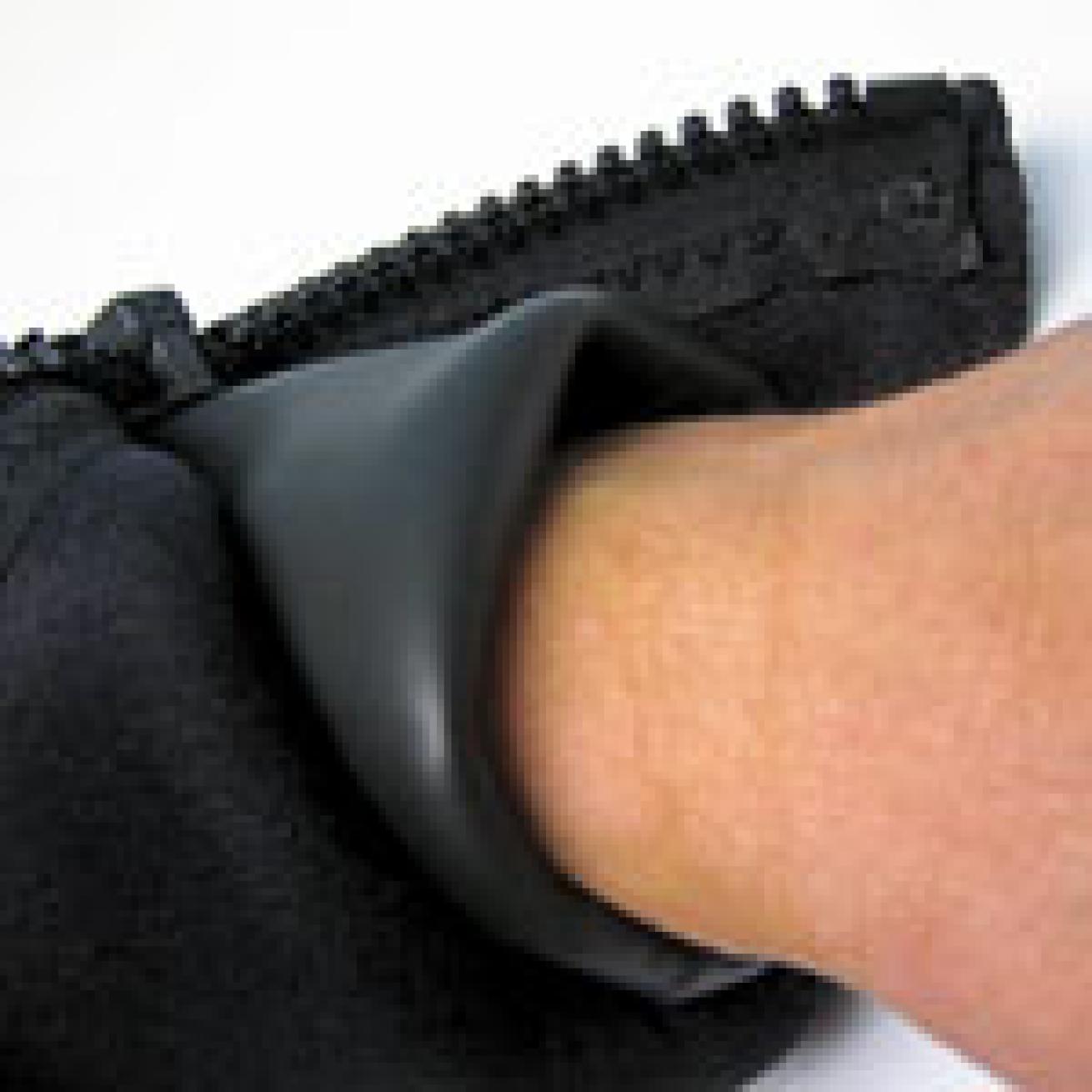
Rolled or fold-under smooth-skin seals. This seal, often found on dry suits, is a long cuff of neoprene with smooth skin on the outside that you roll or fold under so the smooth-skin side seals against your bare skin. It's a very efficient seal and easy to apply, but it tends to be a bit bulky.
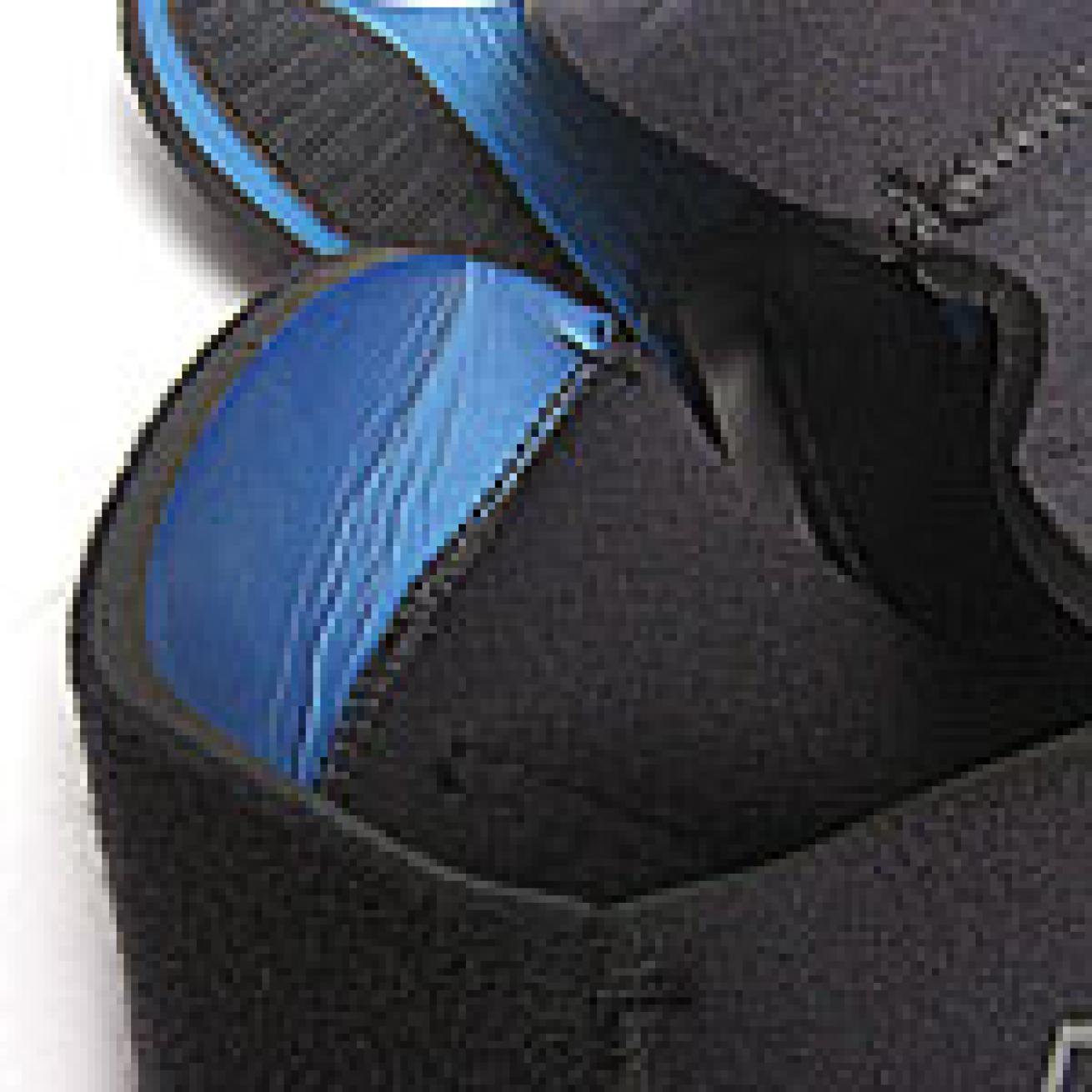
Smooth-skin seals. This is a length of smooth-skin material that runs up the wrists and ankles and/or around the neck. Sealing against bare skin, it provides excellent protection--if the seal isn't broken. Generally, the farther the smooth-skin extends up the forearms and calves, the less likely the seal will be broken. This happens often on ankle seals, where the smooth-skin isn't long enough to reach above the top edge of a diver's tucked-in boot.
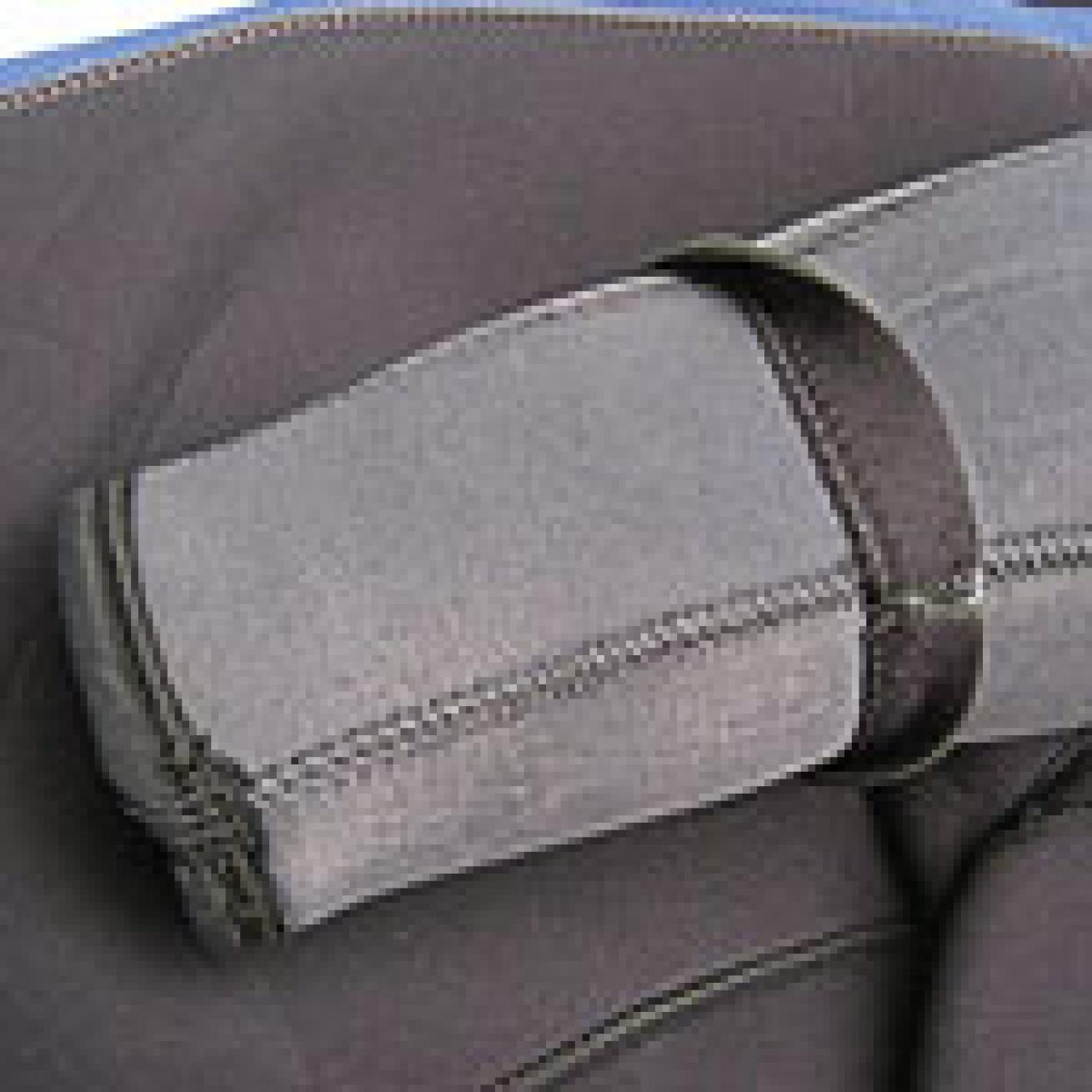
Gasket seals. Basically, these are nylon cuffs at the wrists and ankles, with a one-inch-wide smooth-skin gasket or flap farther up on the forearms and calves. This gasket seals against bare skin and keeps water from getting any farther into the suit, plus keeps boots or gloves from breaking the seals. Be extra careful that the smooth-skin seal doesn't get creased or pinched when pulling on the suit.
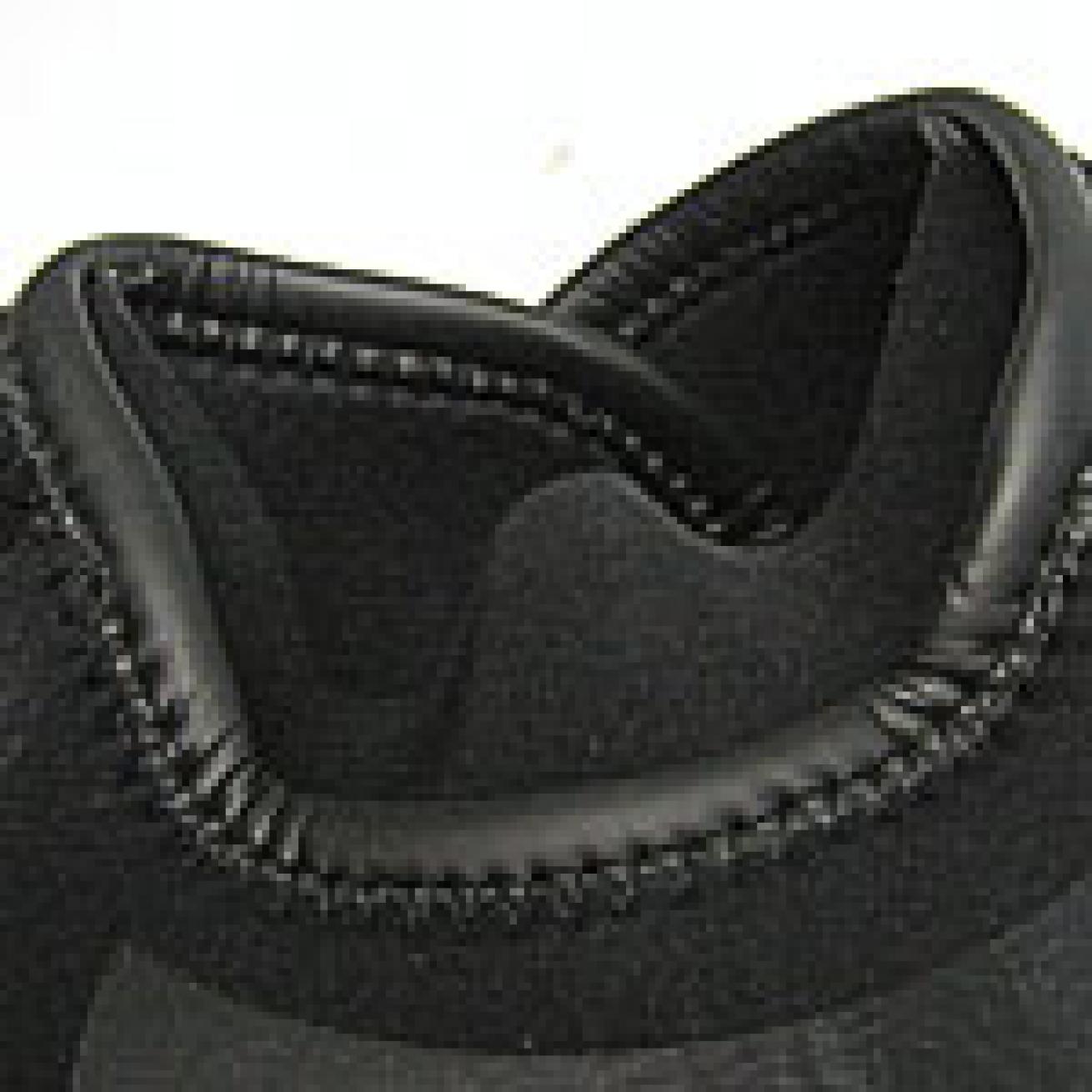
O-ring seals. This is a smooth-skin ring seal, located at the hem of the wrist or ankle cuff, which doesn't get in the way when donning or doffing the suit. However, such a narrow ring of smooth-skin against bare skin creates a seal that is easy to break.
A note on neck seals: 7mm suits are designed for temperate to cold water, environments that require not only a thick suit but a hood. Most wetsuit hoods tuck inside the collar, but this generally breaks whatever neck seal the wetsuit has. If you wear a standard wetsuit hood, don't worry about what kind of neck seal the wetsuit has; instead, tuck in the hood and then adjust the collar as snug as possible to minimize water flow. If the wetsuit has a first-rate neck seal and you don't want to lose it, consider wearing a dry suit hood. These overlap the collar rather than tuck inside, maintaining the integrity of the seal. Another option: some manufacturers offer wetsuit hoods that have a band of smooth-skin sewn around the neck. Tuck the hood into the collar of the suit so that the smooth-skin band makes contact with the smooth-skin neck seal. They bond together, preserving the seal and keeping you dry, warm and comfortable.
Zippers
Often Overlooked
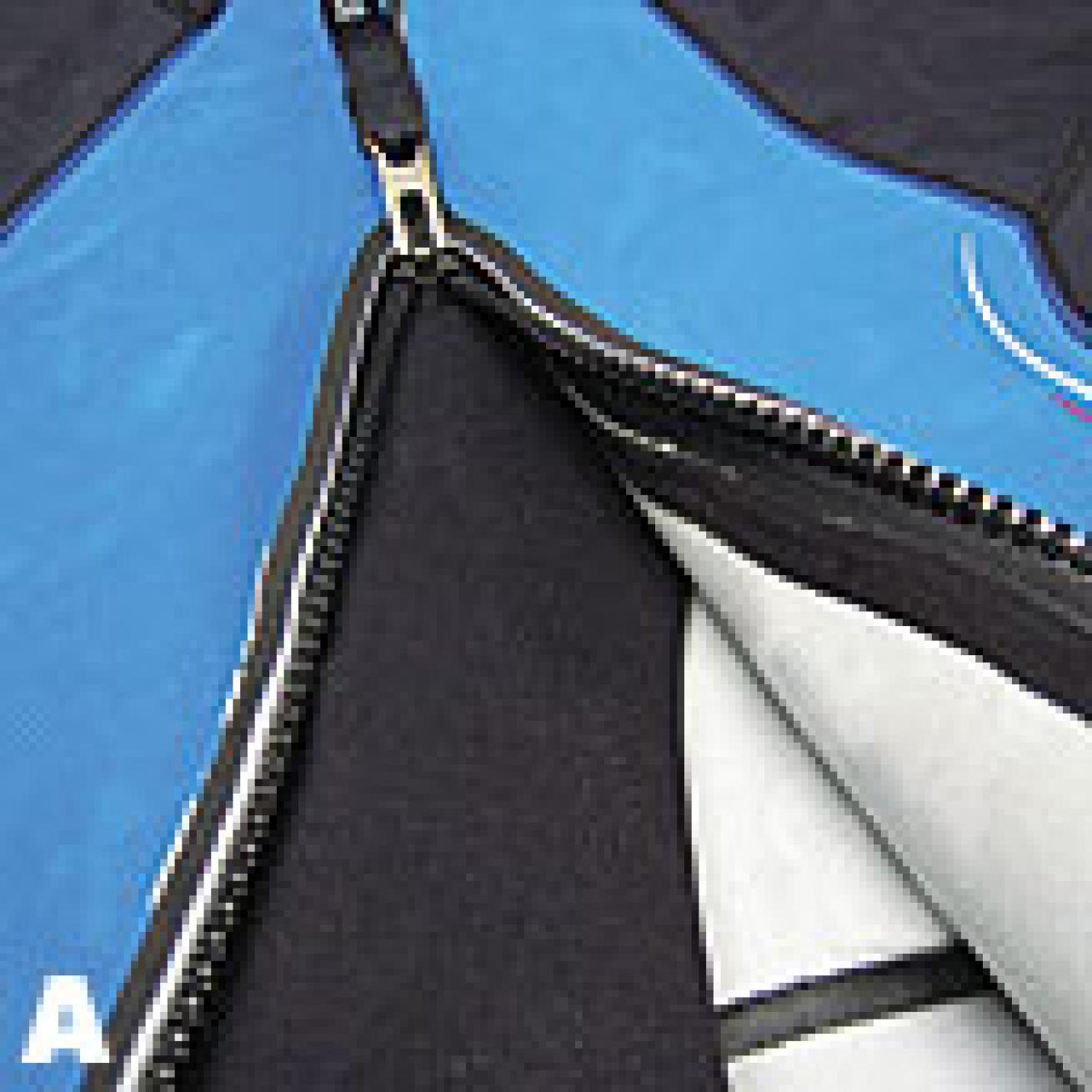

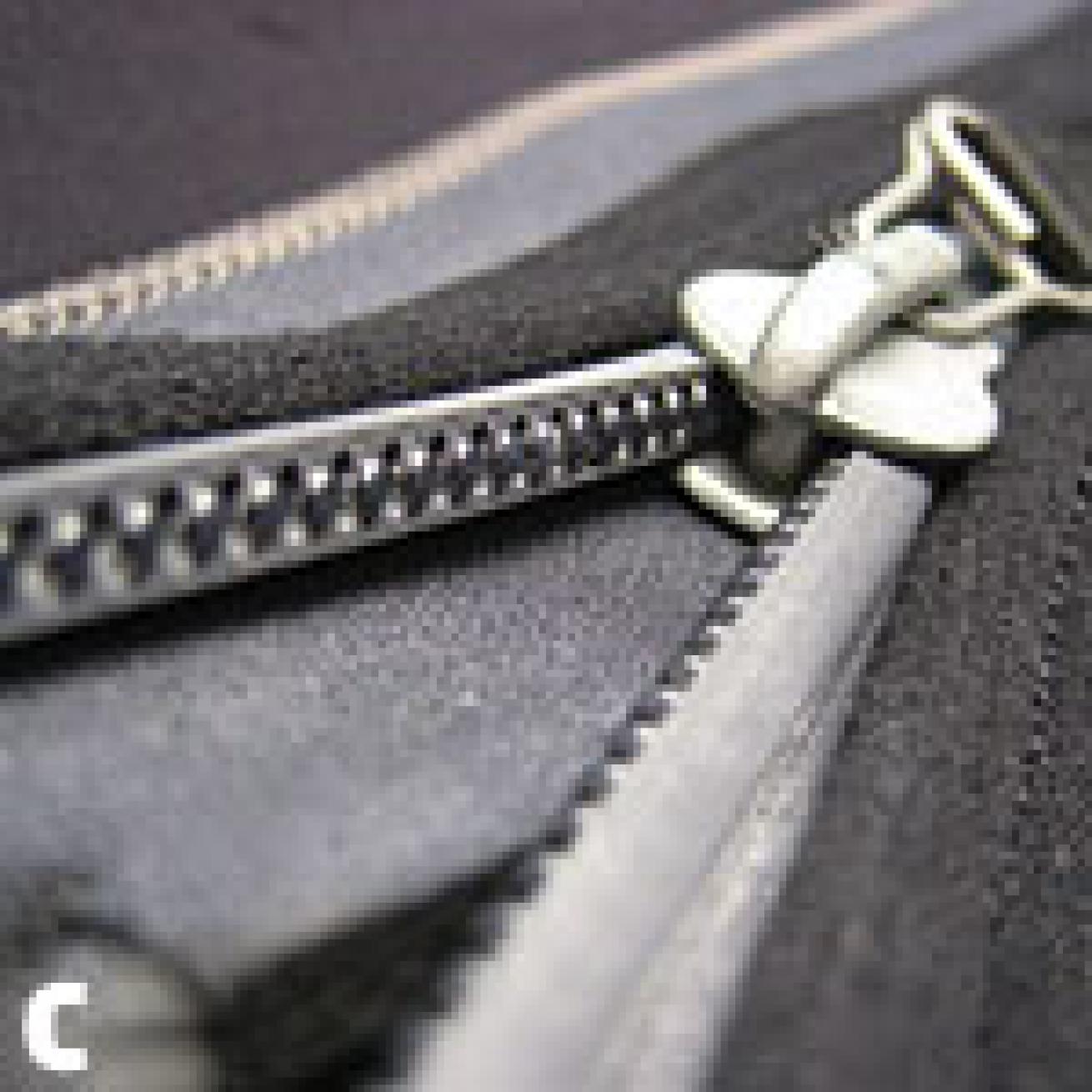
Choosing a 7mm suit with a vertical back zipper or one with a horizontal front zipper is a matter of preference. Front-zipper suits tend to be easier to put on, but the zipper track can affect flexibility in the chest and shoulder areas. Back zippers lay in line with the spine and tend to be more comfortable, but you may need help when zipping up. Whether back or front, the zipper creates the greatest potential for water entry. To combat this, most suits have a zipper underflap that lies between a diver's bare back and a heavy-duty zipper track (A), which helps block water flow (and adds cushioned comfort). Some suits use two sections of smooth-skin neoprene, one on each edge of the zipper track (B). When the zipper is zipped up, the two sections of smooth-skin seal against each other. Finally, a couple of suits use zippers with overlapping teeth that reduce water seepage, and here and there, you'll find a 7mm suit with a dry suit-type zipper with its teeth sandwiched between layers of rubber that create a truly watertight seal (C).
Fit
The Ultimate Challenge
Of course, none of the above--the seals, the seams, the zippers--matters if the wetsuit doesn't fit. Gaps in your armpits and spaces between your legs, behind your knees or along your spine fill up and pump water inside your suit, sucking the heat out of you.
A properly fitting suit fits your body like a second skin, with no gaps or spaces. Finding a good fit can be difficult: Everyone has a unique shape, and even standard sizes like small, medium and large differ by manufacturer. Some suits tend to be designed for muscular divers, others fit lean divers better. Some manufacturers offer a dizzying array of sizes, others offer only the basics. Bottom line: To get a snug-fitting suit, try on as many as you can. If you can't find a stock suit that fits, find a manufacturer that offers custom-made suits.
Akona
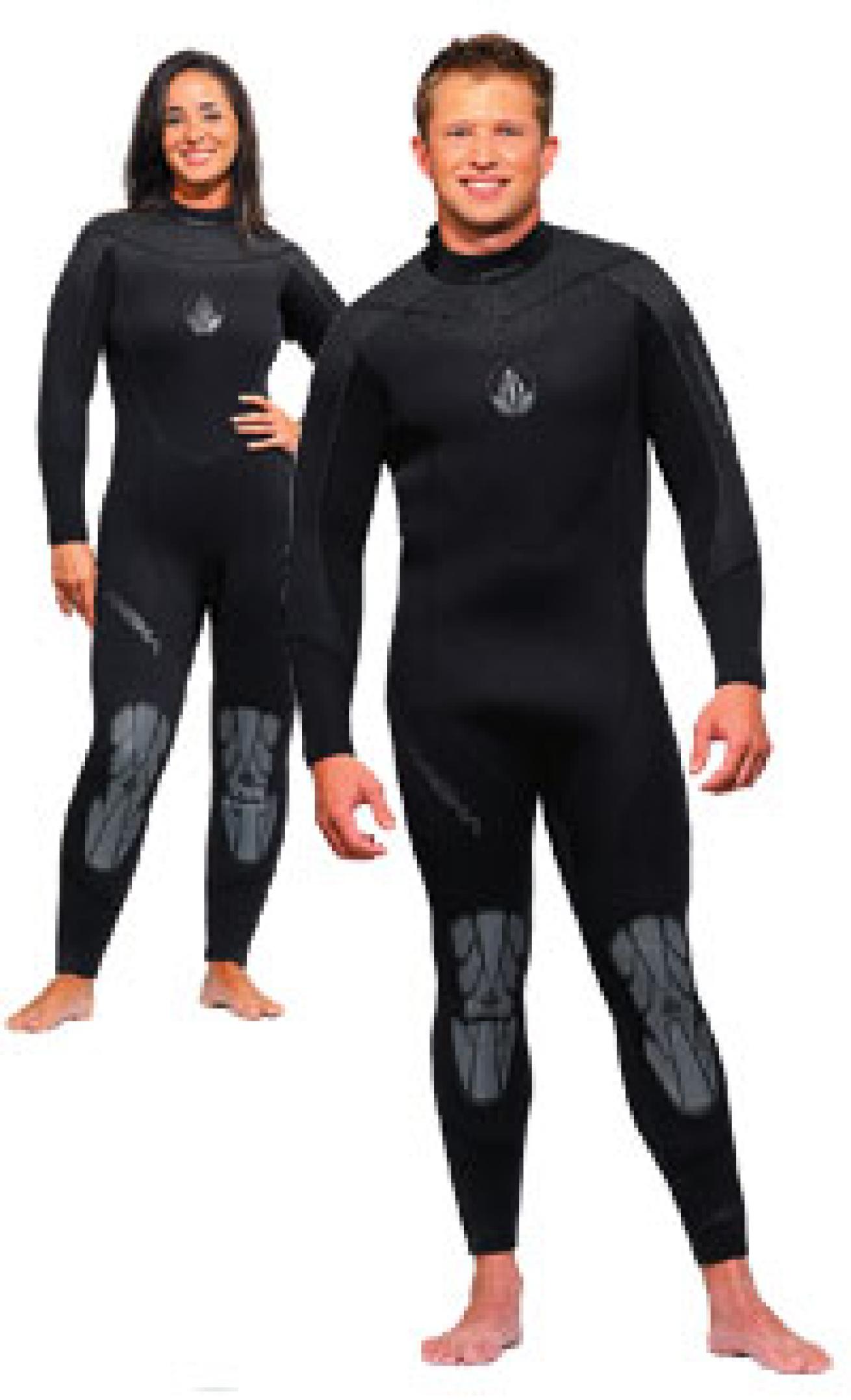
Akona: AKMS508 Full AKMS508 Full
Materials Made with Akona's standard stretch neoprene. Akona's Quantum Stretch (high-stretch) neoprene panels are sewn under the arms and down the legs for increased range of motion. The shoulders are covered with anti-scuff protection to keep BC straps from shifting.
Seams Glued and blind-stitched. A dab of liquid seal is applied at all internal seam ends to keep threads from unraveling.
Seals Neck, wrist and ankle seals feature generous sections of Glideskin smooth-skin sealing material. Smooth-skin sections in the ankles and lower legs are long enough to seal above the tops of dive boots.
Zipper Standard zipper, supported by a padded smooth-skin strip along one side of the zipper track that seals against a smooth-skin underflap. Brass pull and slider.
Performance Stretchy side panels in the legs and Glideskin cuffs allow you to pull on this suit with little effort. Underwater, the suit feels snug and flexible and, best of all, dry, thanks to an excellent sealing system. A reinforced pull loop at the base of the zipper makes putting on the suit fast and easy. Flexible kneepads provide coverage from knee to mid-shin. With the second lowest MSRP of this group, this is a lot of suit for the money.
Sizes 9 men's, 6 women's.
Price $285.
Aqua Lung
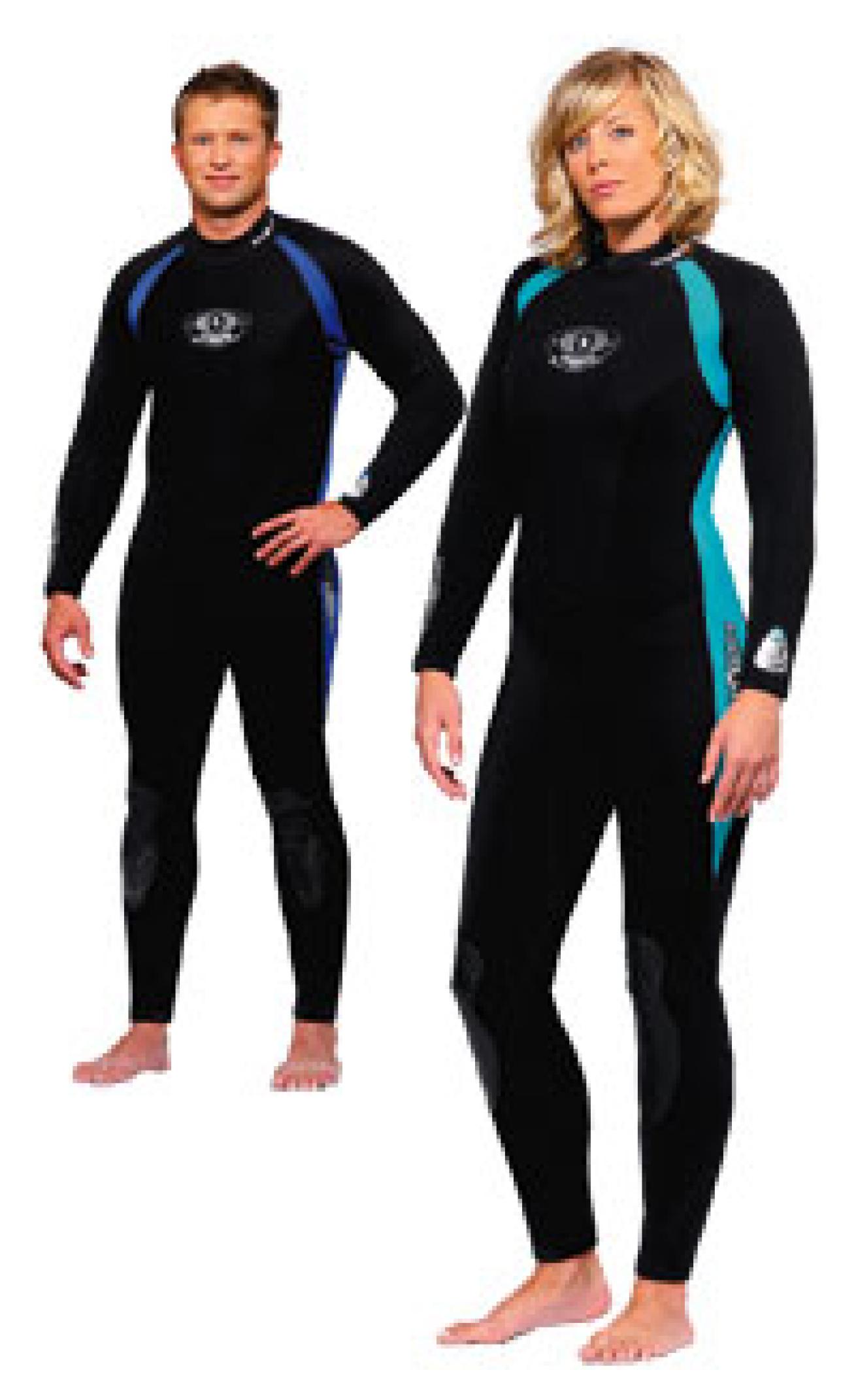
Aqua Lung: Aqua Flex Jumpsuit| Aqua Flex Jumpsuit
Materials Made of Aqua Flex four-way stretch neoprene. According to Aqua Lung, this material offers 250 percent more elasticity than standard neoprene.
Seams Triple-glued and blind-stitched. All seam ends are tacked down to prevent unraveling.
Seals The neck provides an unbroken smooth-skin sealing surface. Wrists and ankles have rolled nylon cuffs, but no seals.
Zipper A three-way zip seal uses strips of smooth-skin neoprene on each side of the zipper track that seal together when the zipper is zipped. This primary seal then seals against a smooth-skin underflap to double the water barrier and create a cushiony spine pad. Brass pull and slider. Bonus: At the base, there's also a built-in kidney pad, for added warmth and comfort.
Performance This high-stretch suit pulls on easily and offers lots of range of motion. The zipper zips smoothly without snagging, a real plus considering the extra material of the three-way zip seal system. Kneepads are well-positioned and segmented for increased flexibility. In the water, the adjustable smooth-skin neck seal was a champ at blocking water flow. The lack of wrist and ankle seals was disappointing; however, the sample wetsuit we tried fit our test divers well enough around the legs to minimize seepage.
Sizes 13 men's, 10 women's.
Price $400.
Bare
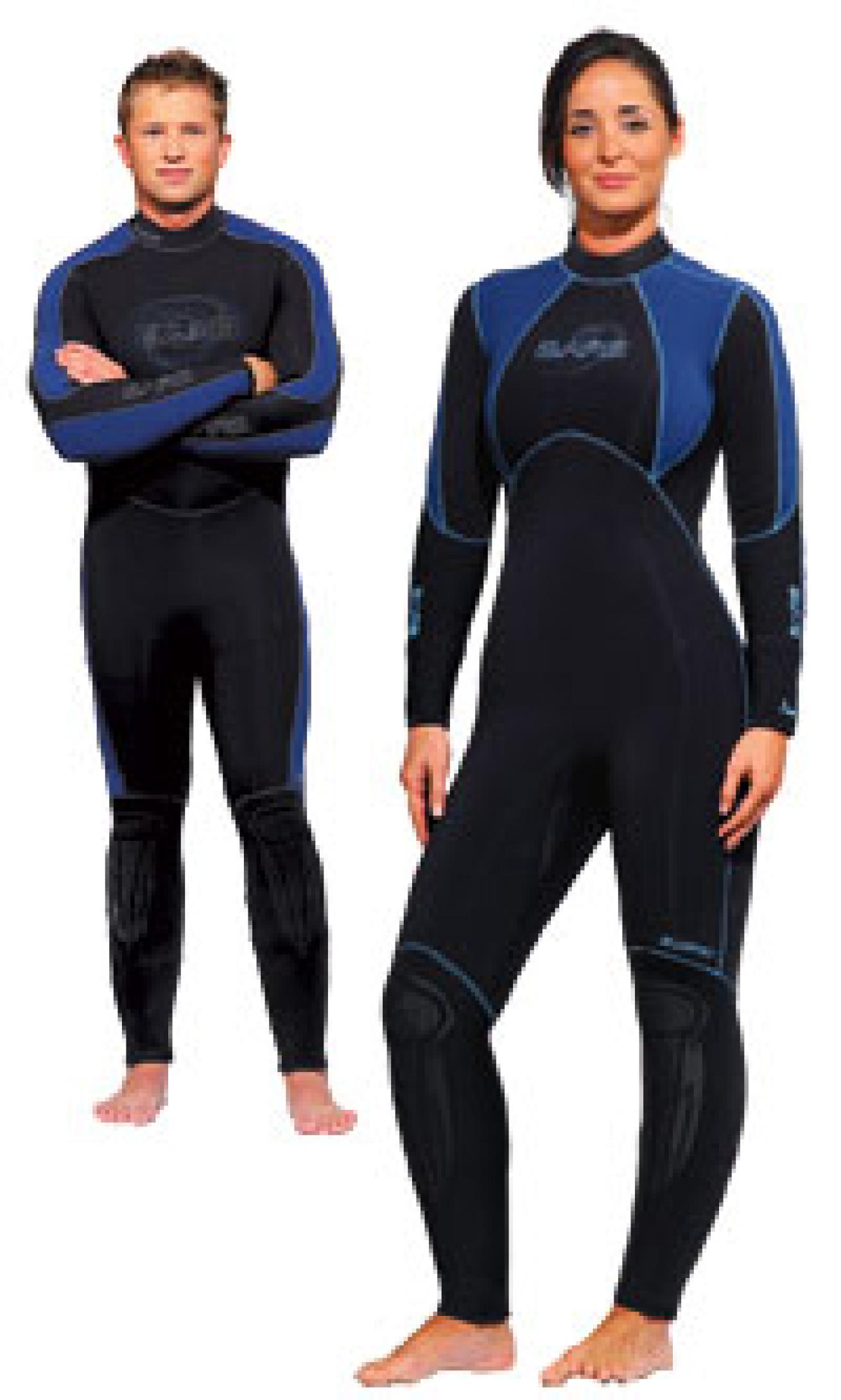
Bare: Elastek Full Wetsuit| Elastek Full Wetsuit
Materials Made with Elastek high-stretch neoprene with 3D anatomically correct shaping in the panels.
Seams Glued and double blind-stitched.
Seals On the neck, Glideseal, a smooth-skin material, creates an unbroken seal when the collar is closed. Wrists and ankles have smooth-skin, gasket-type flap seals, positioned on the lower forearms and mid-calves, backed up by rolled nylon cuffs.
Zipper The G-Lock zipper design uses offset teeth that mesh together to help block water flow. This is supported by a padded smooth-skin strip on one side of the zipper track that seals against a smooth-skin underflap for a tight seal. Metal pull and slider.
Performance The Elastek 7mm is what Bare calls a "full-stretch suit," and it lives up to its name. The material, combined with 3D shaping and pre-bent arms and legs, delivers excellent flexibility and range of motion both in the water and out. The sealing system is first-rate; the neck seal is effective and comfortable, and the leg gasket seals are positioned high enough so that you can easily tuck your boots inside the suit without breaking the seals. The G-Lock zipper pulls up easily without assistance. The flexible Formtek kneepads offer durable leg protection without restricting kicking movement.
Sizes 15 men's, 13 women's.
Price $367.95.
Body Glove
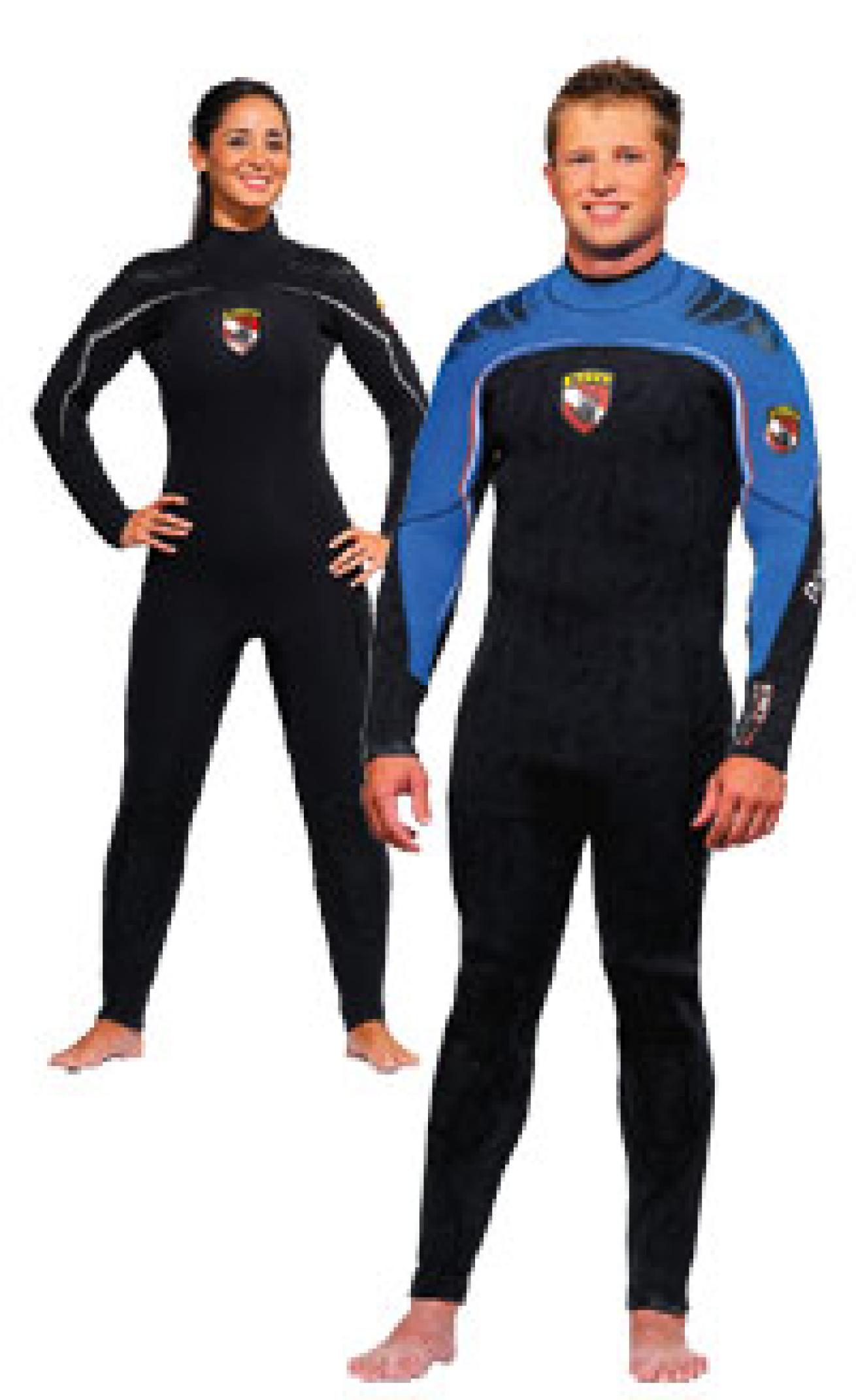
Body Glove: EXO| EXO
Materials Made of 100 percent Future Flex, a high-stretch neoprene with a textured finish and nonslip screening on the shoulders to help keep BC straps from shifting. The interior is lined with Thermofiber, a soft, hollow-fiber material that's comfortable against the skin and, according to Body Glove, helps retain heat.
Seams Triple-glued and blind-stitched. The seams are sewn with a two-thread stitch that automatically ties itself off if the stitch is broken. The inside seam is coated with Fluidseal, Body Glove's name for the liquid tape "weld" that provides an additional barrier to water penetration.
Seals The neck offers an adjustable collar that's comfortable, but provides no sealing properties against water intrusion. Wrists and ankles are fitted with beads of Fluidseal, but the beads don't connect so won't prevent water from seeping in.
Zipper Standard zipper backed by a nylon underflap. Brass pull and slider.
Performance The Future Flex material combined with the Thermofiber lining goes on easy and feels comfortable and flexible. The textured exterior finish looks cool, and while the Fluidseal inner seams feel a bit cold against bare skin at first, it's a small price to pay for a completely waterproof seam. However, this is somewhat neutralized by the absence of sealing surfaces at all other water entry points.
Sizes 9 men's, 5 women's.
Price EXO.
Camaro
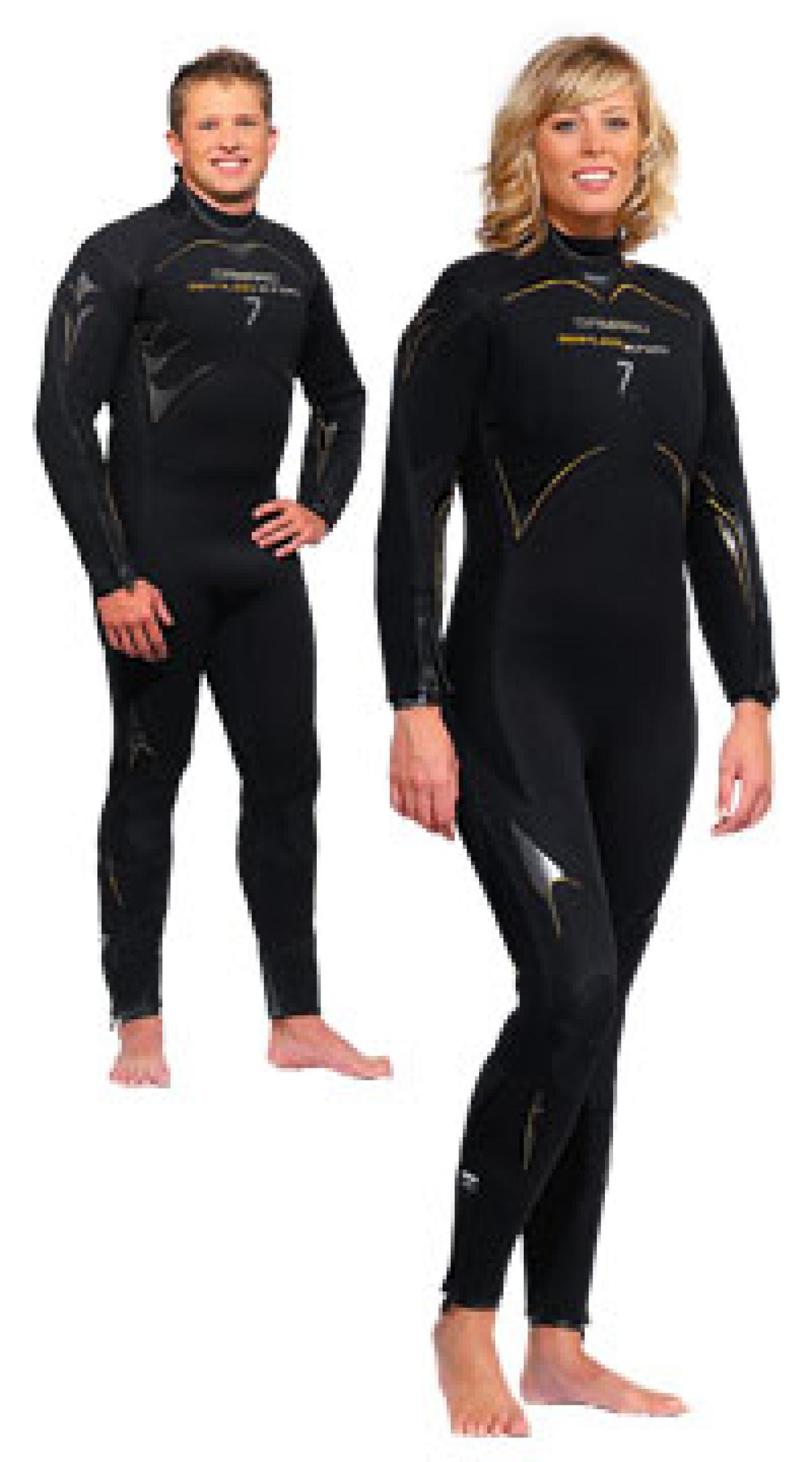
Camaro: Seamless Hydronomic Seamless Hydronomic
Materials Made with four-way stretch neoprene with elastic X-Tend flex panels along the sides, knees and elbows.
Seams Glued-and-taped. Seams are covered with bonding tape that's applied with a combination of heat and pressure to create a flexible, waterproof seam.
Seals The double-collar neck has a smooth-skin band that goes about 75 percent around the adjustable collar. An O-ring-style, smooth-skin edge running along the back offers the potential for a complete seal. Zippered wrists and ankles (with double cuffs) use fold-under smooth-skin seals.
Zipper G-Lock water-blocking zipper. The zipper track is backed up by a pair of underflaps with nylon on one side and smooth-skin on the other. Zipped up, the smooth-skin surfaces seal together while the nylon backing allows for snag-free self-zipping.
Performance The zippered cuffs and four-way stretch material combine to make easy work of donning and doffing this suit. The additional flex panels provide a noticeable range of motion. The fold-under smooth-skin seals on wrists and ankles provide an excellent sealing system. With its smooth-skin neck seal, first-rate zipper and waterproof seams, this suit delivers outstanding protection against water intrusion. The kneepads are not overly large and are well-positioned.
Sizes 16 men's, 8 women's. Price $399.95.
Cressi-sub

Cressi-sub: Comfort Comfort
Materials Made from Ultraspan, Cressi's version of high-stretch neoprene. Large abrasion-resistant panels--a ribbed, stretchy material Cressi calls Strata--provide protection in high-wear areas.
Seams Glued and blind-stitched.
Seals The neck is fitted with an extra-wide smooth-skin seal broken by a three-inch nylon collar flap. Wrists and ankles use one-inch smooth-skin O-ring seals, which are neoprene and coated in Metallite (Cressi calls this its Aquastop system).
Zipper Tizip. This is not a full-on dry suit zipper, but it's darn close. The teeth are sandwiched between rubbery layers that come together to create a watertight surface when the suit is zipped.
Performance This suit is soft and stretchy, making it easy to pull on and off. Wrist and ankle O-ring seals offer extra-large sealing surfaces for this type of seal. The Tizip zipper outdid all other zippers in this group when it came to keeping water out. Instead of traditional rubber kneepads, Cressi uses Strata, a stretchy, ribbed material that offers anti-wear reinforcement on the knees and shoulders.
Sizes 5 men's, 5 women's.
Price $330.
Henderson
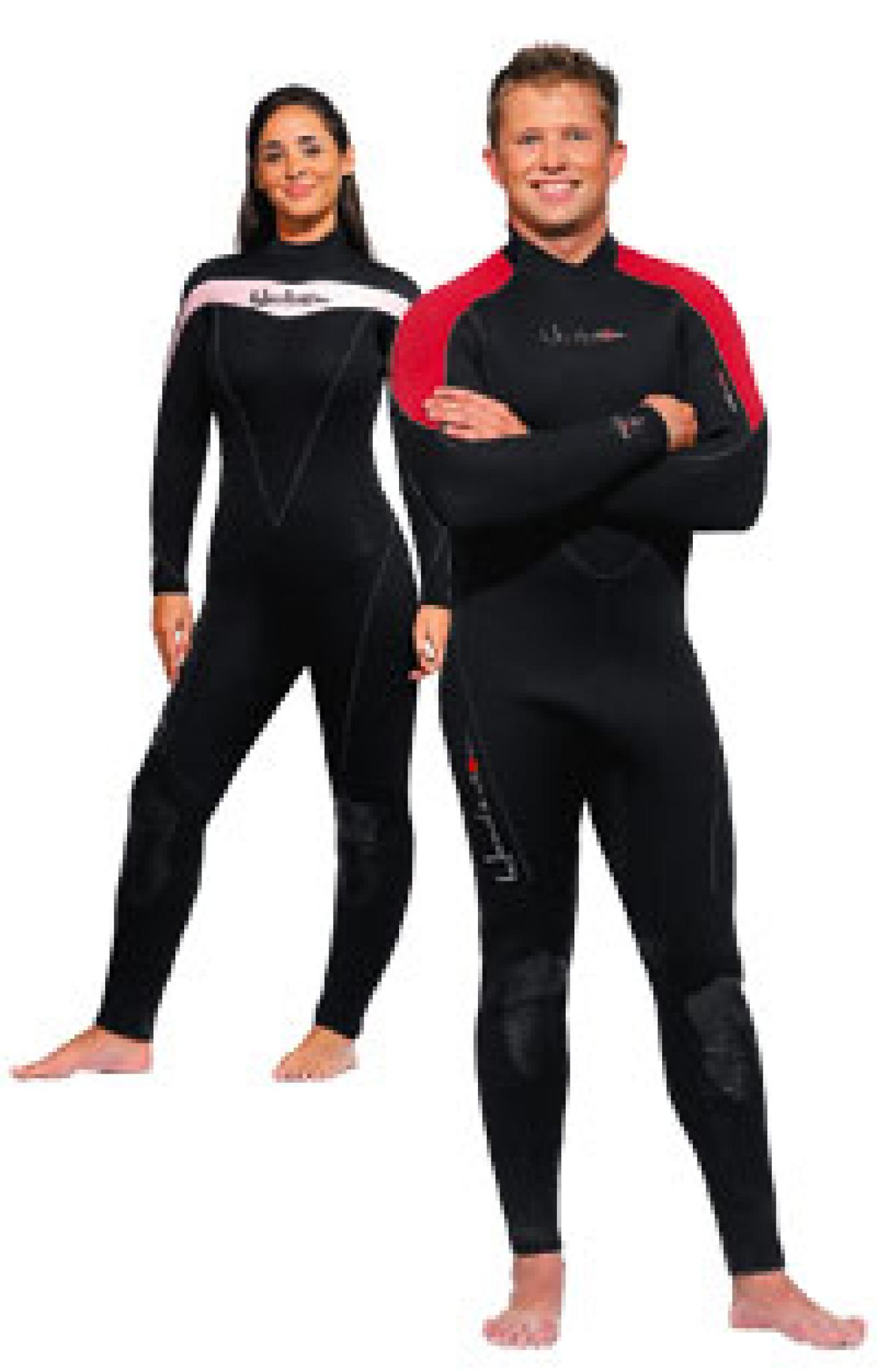
Henderson: Thermoprene Thermoprene
Materials Made of Thermoprene, which has 180 percent more stretch than Henderson's standard neoprene (Thermoprene has replaced standard neoprene in the Henderson line). Bonus: the external nylon layer is resistant to pilling from sticky Velcro.
Seams Glued and double blind-stitched. Trim tape adds a nice finish to the cuffs.
Seals The neck has a smooth-cut nylon collar and wrist and ankles are rolled nylon, none of which provide water-blocking seals.
Zipper Standard zipper, backed by a padded smooth-skin strip along one side of the zipper track that seals against a smooth-skin underflap creating a good sealing surface.
Performance The 7mm suit in Henderson's value-oriented Thermoprene line is an easy suit to don and doff, due to its high-stretch characteristics. The material forms well to body curves and offers plenty of range of motion, making it one of the most comfy suits in this group. The zipper zips and unzips easily without assistance. The lack of sealing surfaces on the neck, wrist and ankles can be offset with a snug fit. Freedom Flex kneepads offer decent protection to the legs. Best of all, this suit is easy on the wallet, coming in with the lowest MSRP in this review.
Sizes 14 men's, 9 women's.
Price $266.99.
Mares
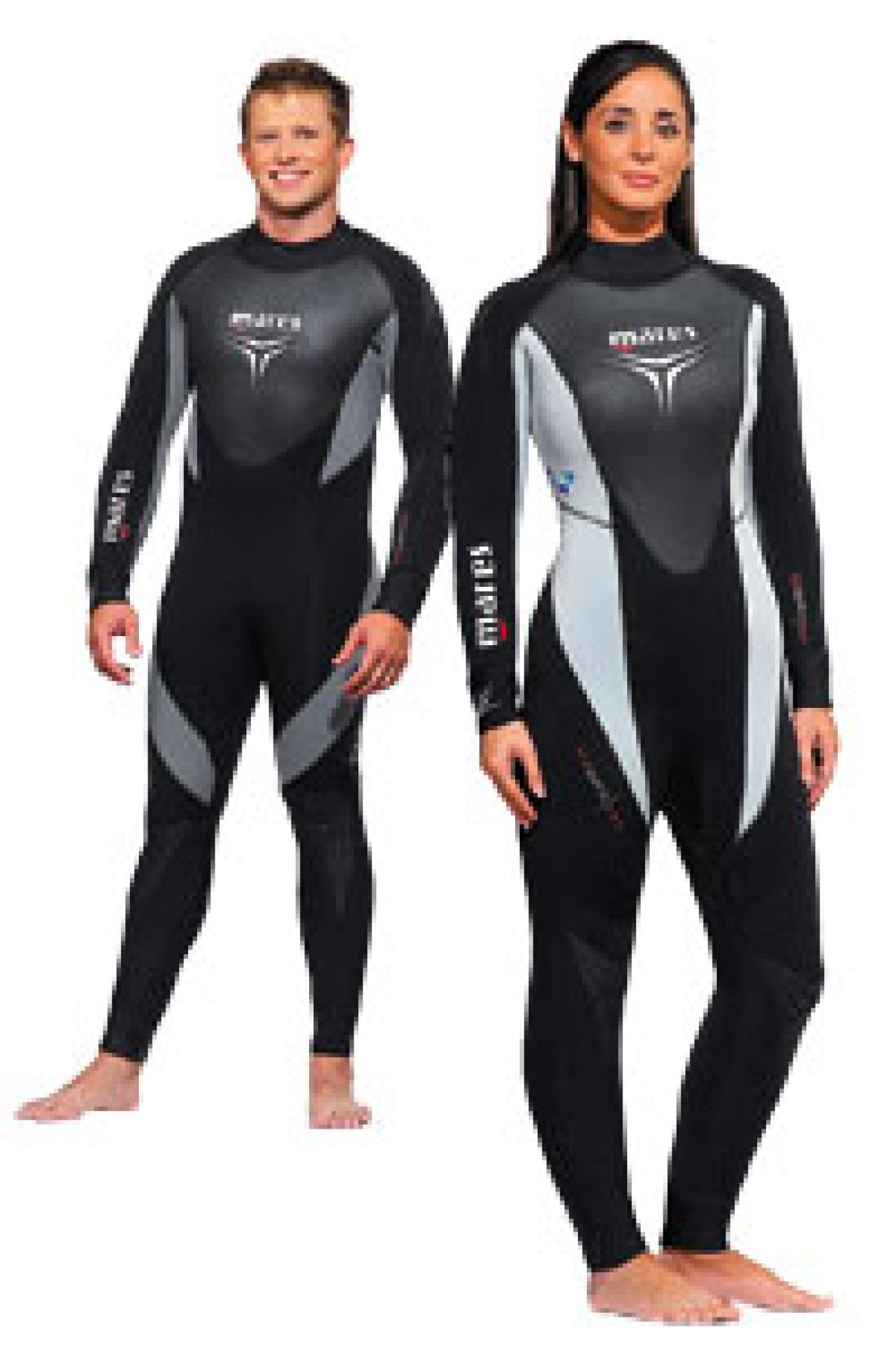
Mares: Trilastic 8-6-5 Trilastic 8-6-5
Materials Made with 8mm Tri-Core smooth-skin flexible neoprene on the chest and back, 6mm high-stretch neoprene on arms and legs, and 5mm neoprene with Sapphfire skin lining on neck, wrist and ankle seals. Shoulders and knees are protected by an abrasion-resistant polyurethane pattern. Inside, chest and thigh panels are lined with Sapphfire Plush.
Seams Glued and blind-stitched. All internal thread ends are tacked down with glue.
Seals On the neck, a smooth-cut Sapphfire Skin collar offers a partial seal that's broken by a five-inch section of padded nylon. Wrists and ankles feature nice Sapphfire Skin seals.
Zipper Standard zipper. A narrow, padded smooth-skin strip on one edge of the zipper track seals against a smooth-skin underflap to create a solid sealing surface.
Performance This suit attacks the 7mm market from a unique angle, putting 8mm neoprene in the body's core area for warmth and 6mm where range of motion is most important. The combination is a winner. The smooth-skin finish on the chest and back panels reduces evaporative cooling on the surface--the only suit in this review with this feature. The internal plush lining feels great and helps reduce water transfer.
Sizes 5 men's, 6 women's.
Price $400.
O'Neill

O'Neill: Sector FSW Full Sector FSW Full
Materials Made of 100 percent Ultraflex DS (durable super-stretch) neoprene throughout. On the inside, the torso area is lined with Firewall insulation. This is a lightweight, insulating-fiber jersey material that wicks away moisture and, according to O'Neill, increases warmth.
Seams Triple-glued and blind-stitched. The outside stitch is also sealed with a Fluid Seam Weld, O'Neill's name for the liquid tape that provides an additional barrier to water penetration.
Seals The neck is fitted with a smooth-skin seal interrupted by a four-inch section of nylon that's part of the adjustable collar system. Wrists and ankles use Glideskin O-ring cuff seals.
Zipper Code Red, a water-resistant zipper with double overlapping teeth coated with urethane to tighten the tolerance even further. The zipper is backed by a nylon underflap.
Performance The Sector suit pulls on and zips up easily. The urethane-coated water-blocking zipper eliminates virtually all water seepage. The strategically located Ultraflex stretch panels lend lots of flexibility to this suit and enhance overall comfort. The neck seal is comfortable, though not watertight. Heavy-duty kneepads offer excellent lower-leg protection.
Sizes 12 men's, 9 women's.
Price $349.95.
Pinnacle Aquatics
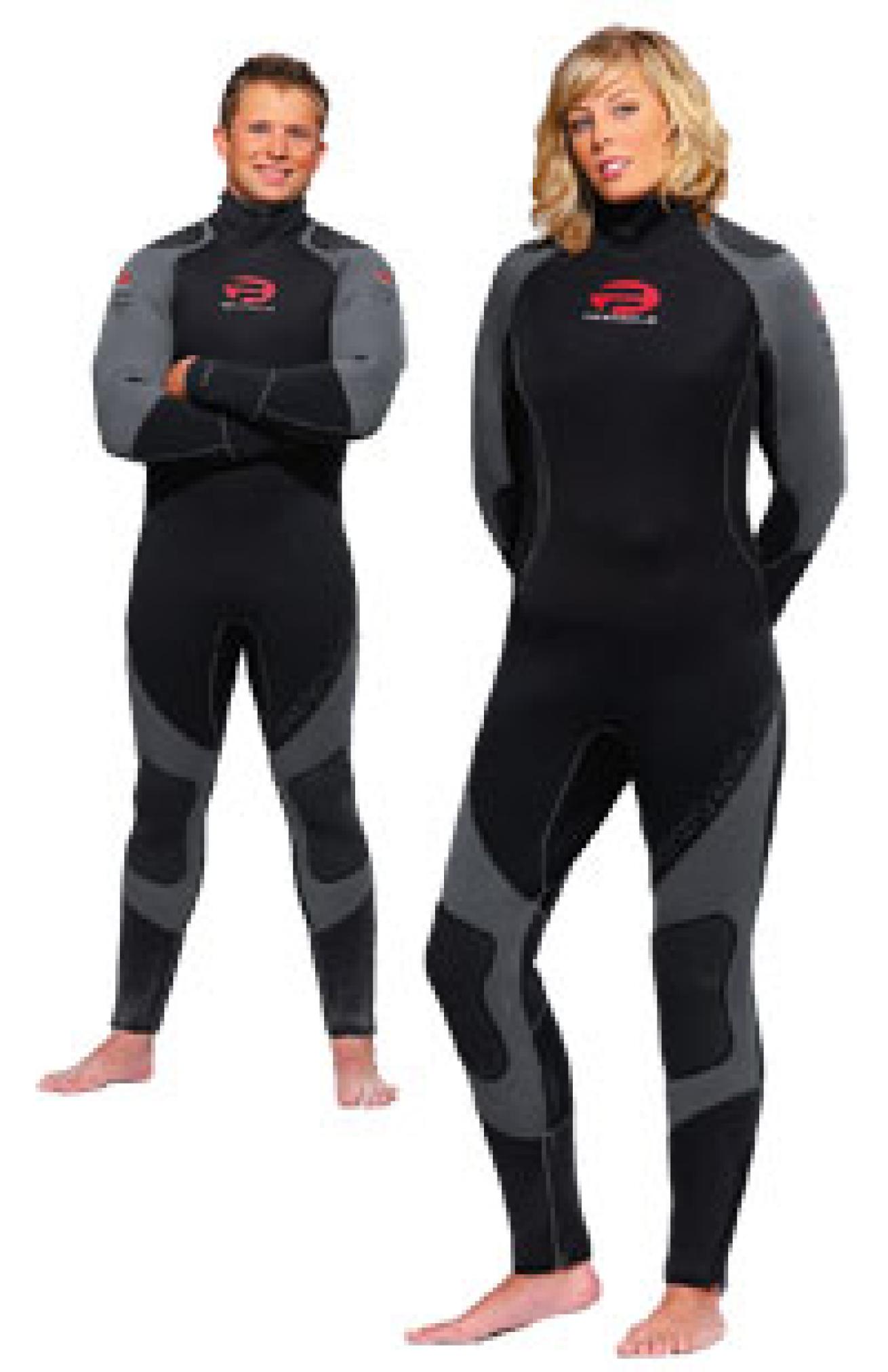
Pinnacle Aquatics: Element Element
Materials Made with titanium-lined Elastiprene neoprene. Flex panels in the elbows and behind the knees improve range of motion. The interior is covered with Merino, a soft liner material that, according to Pinnacle, promotes warmth, comfort and odor control.
Seams Glued and blind-stitched. All internal seam ends and intersections are secured by glue-down stress discs.
Seals The neck uses a smooth-skin rolled collar that creates an excellent continuous seal when the collar is closed. Wrists use extra-long gasket seals that start at mid-forearm. These are backed up by O-ring wrist cuffs. Ankles use fold-under smooth-skin seals backed by zippered over-cuffs.
Zipper The zipper has offset teeth to reduce water flow. It's backed by a thick, 10mm nylon underflap that doubles as a spine pad, but doesn't provide any sealing properties.
Performance The Element is not as stretchy as some of the other suits in this go-round, but the anatomically bent arms and legs, plus the flex panels at the elbows and behind the knees, give the suit enough range of motion to make it comfortable. The Merino lining is comfy, and the neck, wrist and ankle seals are about the best of this group. The Kevlar kneepads are tough and look right at home on this rugged suit.
Sizes 17 men's, 11 women's.
Price $429.
Scubapro
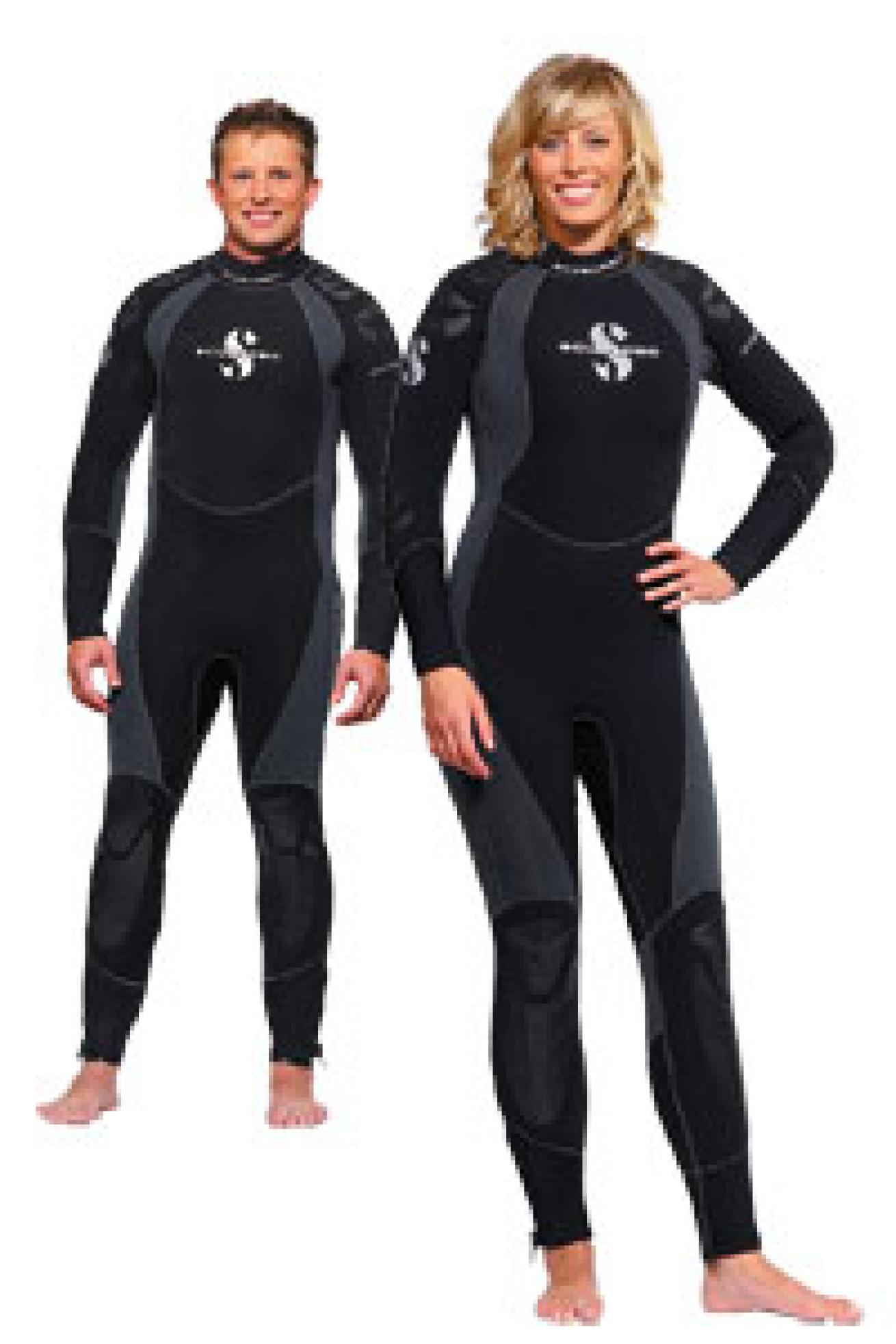
Scubapro: Everflex Steamer 7/5 Everflex Steamer 7/5
Materials Made with high-stretch, nonpetroleum-based Everflex neoprene, this suit uses 7mm in the core warming areas, with 5mm panels strategically placed to increase flexibility. Inside, the suit is lined with Heliospan, a comfortable, super-fine fleece weave.
Seams External seams are glued and double-thread blind-stitched, a sewing technique that uses two threads and an interlocking stitch to help prevent seams from unraveling if the thread is cut. Internal seams are glued and single-thread blind-stitched to make the seams more comfortable against bare skin.
Seals The neck uses a partial Glideskin smooth-skin seal. Wrists use extra-long Glideskin seals while ankles use a smooth-skin fold-under seal covered by a zippered cuff.
Zipper Standard zipper backed by a padded smooth-skin underflap with an opposing sealing strip. Brass pull and slider.
Performance A combination of thermally efficient 7mm neoprene and 5mm neoprene in flex areas makes this a very comfortable suit. The Heliospan lining is soft and makes donning and doffing easy business. Ankle seals are first-rate, and the long sections of Glideskin in the forearms let hands slide through easily but seal snugly to prevent water flow. A large web loop at the base of the zipper makes it possible to zip the suit up without assistance. Heavy-duty Tatex kneepads offer excellent protection, while shoulders and elbows are covered with a nonskid pattern to keep BCs from slipping.
Sizes 7 men's, 7 women's.
Price $395.
Waterproof
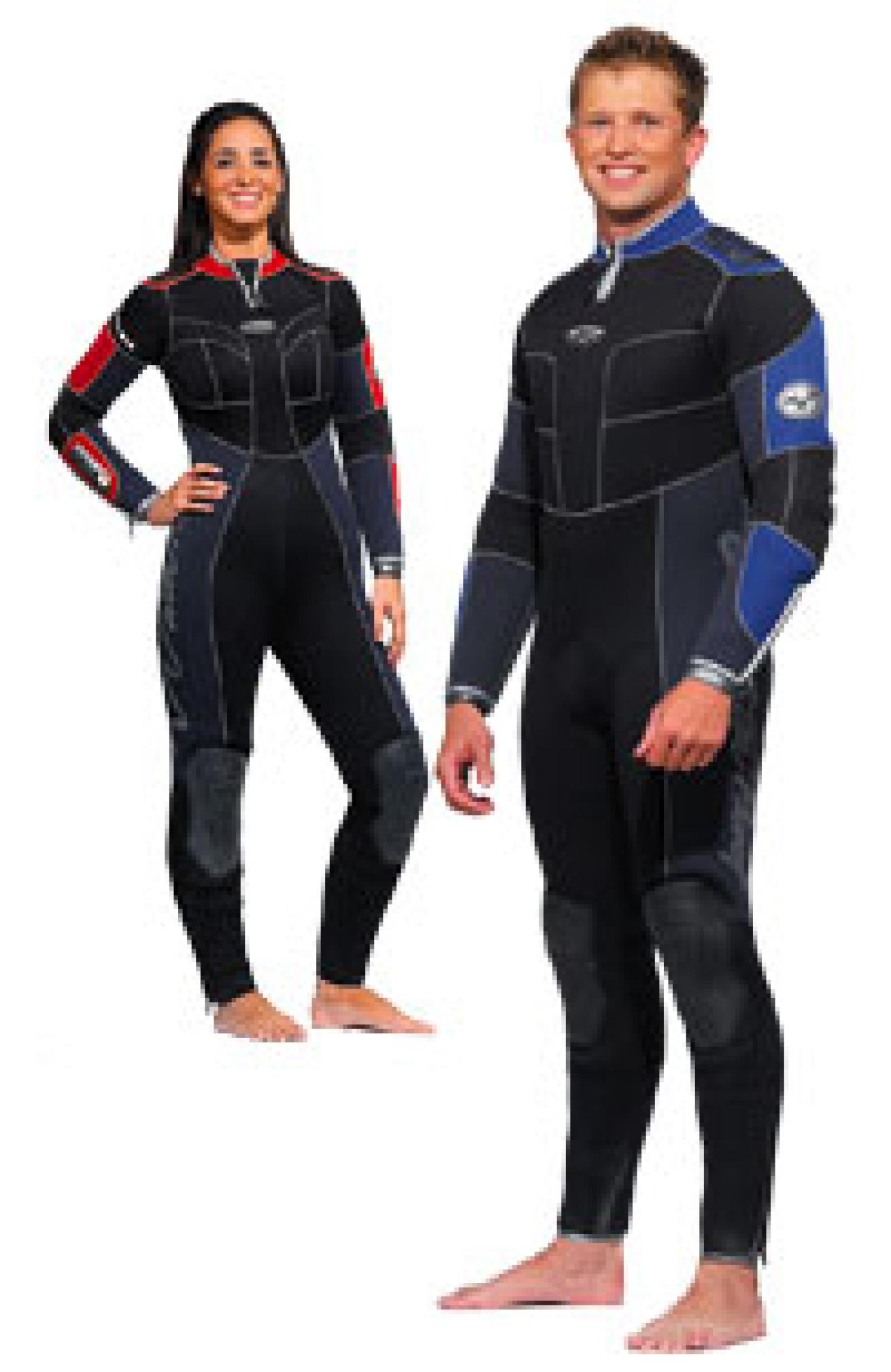
Waterproof: Aries Aries
Materials Made with high-density CR Microcell neoprene. Wave Flex panels at elbows, behind knees and in the lower back fit your body, while high-wear areas like the backside and shoulders are coated with abrasion-resistant polyurethane. The interior is completely plush-lined.
Seams Glued and blind-stitched. Seam edges are finished with trim tape.
Seals The neck is smooth-skin, with a short comfort zipper in front that relieves collar pressure on the surface, but breaks the integrity of the seal. Wrists and ankles use smooth-skin fold-under seals under zippered cuffs.
Zipper Standard zipper with a smooth-skin strip along one edge of the zipper track that seals against a 10mm smooth-skin underflap. A thin strip of nylon-covered neoprene right behind the zipper track keeps the zipper car from snagging. Brass pull and slider.
Performance Waterproof uses anatomically shaped neoprene panels that are sewn together to provide both thermal protection and fit. The all-plush lining, combined with wrist and ankle zips, makes for one of the easiest suits to don and doff. The thick spine pad/zipper flap with its smooth-skin surface did a great job of filling the space and foiling water flow. The Aries comes in more sizes than any wetsuit in this group.
Sizes 28 men's, 30 women's.
Price $431.08 for standard sizes; $443.15 for tall and plus sizes.

